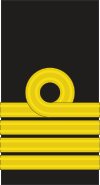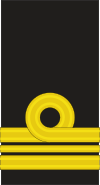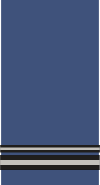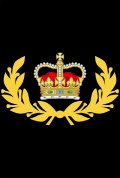Canadian Armed Forces ranks and insignia
This is a table of the ranks and insignia of the Canadian Armed Forces. As the Canadian Armed Forces is officially bilingual, the French language ranks are presented following the English (in italics).
Commander-in-Chief
The Queen of Canada, represented by the Governor General, is the Commander-in-Chief of the Canadian Forces, and in that capacity may wear the appropriate Canadian Armed Forces uniform.[1][2] The sleeve braid is embellished with the Royal Crest of Canada and this same embroidered crest is worn on the shoulder straps.
| Commander-in-Chief as | |||
|---|---|---|---|
| Naval Officer | Army Officer | Air Force Officer | |
 |
 |
 |
Crest of the Arms of Her Majesty The Queen in Right of Canada[3] |
Flag officer / General officer rank insignia
| Navy | Army | Air Force | Description | |||
|---|---|---|---|---|---|---|
| Admiral / amiral | General / général | General / général | ||||

|

|

|

|

|

|
St. Edward's crown, crossed sabre and baton, four maple leaves Army: St. Edward's crown, one Star and a crossed sabre and baton |
| Vice Admiral / vice-amiral | Lieutenant General[4] / lieutenant-général |
Lieutenant General[4] / lieutenant-général | ||||

|

|

|

|

|

|
St. Edward's crown, crossed sabre and baton, three maple leaves Army: St. Edward's crown and a crossed sabre and baton |
| Rear Admiral / contre-amiral | Major General / major-général | Major General / major-général | ||||

|

|

|

|

|

|
St. Edward's crown, crossed sabre and baton, two maple leaves
Army: A single Star and a crossed sabre and baton |
| Commodore | Brigadier General / brigadier-général |
Brigadier General / brigadier-général | ||||

|

|

|

|

|

|
St. Edward's crown, crossed sabre and baton, one maple leaf Army: Crossed sabre and baton |
Officer rank insignia
| Navy[5] | Army[6] | Air Force[7] | Description | ||||
|---|---|---|---|---|---|---|---|
| Captain / Capitaine de vaisseau |
Colonel | Colonel | |||||

|
 
|

|
RCN and RCAF : Four rows of standard braids (naval with executive curl) Army: St. Edward's Crown and two Stars (Colonel gorget) | ||||
| Commander / Capitaine de frégate |
Lieutenant Colonel[4] | Lieutenant Colonel[4] | |||||

|

|

|
RCN and RCAF : Three rows standard braids (naval with executive curl) Army: St. Edward's Crown and one Star |
||||
| Lieutenant-Commander[4] / Capitaine de corvette |
Major | Major | |||||

|

|

|
RCN and RCAF : One row narrow braid between two rows of standard braids (naval with executive curl) Army: St. Edward's Crown | ||||
| Lieutenant[4] / Lieutenant de vaisseau |
Captain / Capitaine | Captain / Capitaine | |||||

|

|

|
Navy : Two rows standard braid with executive curl Air Force: Two rows standard braid Army: Three Stars | ||||
| Sub-Lieutenant[4] / Enseigne de vaisseau de première classe |
Lieutenant[4] | Lieutenant[4] | |||||

|

|

|
Navy : One row standard braid with executive curl over one row of narrow braid Army: Two Stars Air Force: One row of narrow braid over one row standard braid | ||||
| Acting Sub-Lieutenant[4] / Enseigne de vaisseau de deuxième classe |
Second Lieutenant[4] / Sous-lieutenant |
Second Lieutenant[4] / Sous-lieutenant | |||||

|

|

|
Navy: One row standard braid with executive curl Air Force: One row standard braid Army: One Star | ||||
| Naval Cadet / Aspirant de marine |
Officer Cadet / Élève-officier |
Officer Cadet / Élève-officier | |||||

|

|

|
Navy and Air Force: One row of narrow braid. Army: One Star in a white ribbon. | ||||
Non-commissioned member rank insignia
| Navy[8][9] | Army[10][11] | Air Force[12][13] | Description |
|---|---|---|---|
| Senior Appointments | |||
| Canadian Forces Chief Warrant Officer
(CFCWO) |
Canadian Forces Chief Warrant Officer
(CFCWO) |
Canadian Forces Chief Warrant Officer
(CFCWO) |
The simplified version of the 1957 Coat of Arms of Canada within a wreath of maple leaves. |
| Chief Petty Officer of the Navy
|
Command Chief Warrant Officer
|
Command Chief Warrant Officer
|
A simplified version of the 1957 Coat of Arms of Canada over a wreath of laurel. |
| Formation Chief Petty Officer
|
Formation Chief Warrant Officer
|
Formation Chief Warrant Officer
|
A simplified version of the 1957 Coat of Arms of Canada over tri-service emblem. |
| Senior ranks (Rangs supérieurs) | |||
| A simplified version of the 1957 Coat of Arms of Canada. | |||
| St. Edward's Crown within a laurel wreath. | |||
| St. Edward's Crown. | |||
| Three-bar chevron surmounted by a maple leaf | |||
| Junior ranks (Rangs subalternes) | |||
| Two-bar chevron surmounted by a maple leaf. | |||
| Two-bar chevron. | |||
| One-bar chevron.
Airforce: One propeller. | |||
| No insignia. | |||
Service stripes
From 1955 to 1968 Militia personnel were permitted to wear service insignia on the right jacket sleeve.[14][15] There were 1 to 5 silver chevrons on drab backing for every 2 years of service or a Maple Leaf in silver thread on a drab cloth circle to represent 10 years of service. Chevron points were worn either up or down; even official documents and photos were confused on the matter. Further awards after 10 years were believed covered by the Canadian Forces Decoration, which was awarded after 12 years and a clasp added for every 10 years afterwards.
Qualifying service could include prior active service in the active reserves of the Royal Canadian Navy and Royal Canadian Air Force or the Regular or Territorial forces of a fellow Commonwealth member nation. Service in Canadian Army reserve forces units (like the Regular Reserve, Supplementary Reserve and Reserve Militia) did not count. The awarding of Service Stripes ceased in 1968 after the Canadian military was unified into the Canadian Armed Forces.
Distinctive rank names
Some branches and regiments use distinctive rank names in place of master corporal, corporal and private:
| Branch | Master corporal | Corporal | Private |
|---|---|---|---|
| Royal Canadian Armoured Corps | Master corporal (caporal-chef) | Corporal (caporal) | Trooper (cavalier) |
| Royal Regiment of Canadian Artillery | Master bombardier (bombardier-chef) | Bombardier (bombardier) | Gunner (artilleur) |
| Corps of Royal Canadian Engineers | Master corporal (caporal-chef) | Corporal (caporal) | Sapper (sapeur) |
| Royal Canadian Corps of Signals | Master corporal (caporal-chef) | Corporal (caporal) | Signalman (signaleur) |
| Corps of Royal Canadian Electrical and Mechanical Engineers | Master corporal (caporal-chef) | Corporal (caporal) | Craftsman (artisan) |
| Royal Canadian Infantry Corps (RCIC) members of guards regiments | Master corporal (caporal-chef) | Corporal (caporal) | Guardsman (garde) |
| RCIC members of rifle regiments | Master corporal (caporal-chef) | Corporal (caporal) | Rifleman (carabinier) |
| RCIC members of fusilier regiments | Master corporal (caporal-chef) | Corporal (caporal) | Fusilier (fusilier) |
In the guard regiments, Warrant Officers are known as Colour Sergeants and Second Lieutenants are known as Ensigns.

Except for those who acquired the Canadian Forces mess dress after 1968 to 2010, naval officers have always worn the Royal Navy-style executive curl rank insignia on mess uniforms (see Royal Navy officer rank insignia). The colour designations for specialist officers are not used except for naval medical officers who may use a variant of the standard rank slip-ons and shoulder boards incorporating a scarlet red background between the gold braid of their rank insignia and naval medical service officers (nursing officers, pharmacy officers, health care administration officers, social work officers, physiotherapy officers, and bioscience officers) who have shoulder boards incorporating a dull cherry red background between the strips of their rank.
The Royal Canadian Navy and the executive curl
When the Canadian Navy was established in 1910 it was natural to adopt the same straight rings with the executive curl for the permanent navy that was designated as the Royal Canadian Navy (RCN) in August 1911 and subsequently the “wavy” shaped rings for the Royal Canadian Naval Volunteer Reserve (RCNVR) and the rings of narrow interwoven gold lace for the Royal Canadian Navy Reserve (RCNR). Other variations in rank insignia included sky blue lace with a diamond shaped loop for officers of the Women's Royal Canadian Naval Service and warranted Sea Cadet Corps Officers who had a small anchor in place of the executive curl.
Following the Second World War, the Royal Canadian Navy was reorganized with a single reserve component. In 1946 the distinctive wavy gold braid of the reserves gave way to the straight braided executive curl of the regular force until 1968. With the integration of the Canadian Forces the sea element was designated as Canadian Forces Maritime Command. Unembellished straight braid became the common rank insignia for officers of both the Regular and Reserve Forces. The executive curl rank insignia has been in continuous use in the Royal Canadian Navy, but from 1968 to 2010 it appeared only on navy mess dress.
On 5 March 2010, the Canadian House of Commons passed a motion (moved by Guy Lauzon[16]) recommending the executive curl be reinstated on the Canadian navy uniform. Subsequently, in recognition of the Canadian Naval Centennial, Peter MacKay, Minister of National Defence, authorized the use of the executive curl for the Canadian Navy on 2 May 2010. The insignia became effective on 11 June 2010, on the occasion of the Pacific Canadian Naval International Fleet Review parade of nations in Victoria, B.C.[17][18]
More than 54 countries including Canada and 18 other of the 22 Commonwealth navies use the insignia. Most navies that do not use the executive curl insignia substitute a star or other national device above the top row of lace such as the United States Navy and the French Navy.
Reinstatement of Canadian Army ranks and insignia
The Minister of National Defence, Peter McKay, announced on 8 July 2013 their intention to restore the traditional rank names for all Canadian Army non-commissioned members, as well as the reintroduction of Canadian Army officers' rank insignia.[19] Instead of the air force style rank insignia, Canadian Army officers will once again use the traditional "Stars and crowns", a system which is more than one hundred years old.[20] The traditional gorget patches are also to be restored for officers of the rank of colonel or higher.[21] The re-introduction of Canadian Army rank insignia is expected to save the Canadian Armed Forces $53,550 per year, but with an initial outlay of $245,000, savings are not expected to be realised until after the first five years.[22] The reasons behind the return to the traditional Canadian Army ranks and insignia were explained by the Minister of National Defence as strengthening Canadian Army identity as "our officers who accepted the (German) surrender, were wearing Stars and Crowns. This in no way diminishes Canada's identity, and I would suggest we are returning to the insignia that was so much a part of what the Canadian Army accomplished in Canada’s name".[23]
The reinstated insignia for officers, instead of using the current rank insignia for Brigadier (used until 1966), had the pre-1920 Brigadier-General insignia (crossed sabre and baton) instead.
Reinstatement of Royal Canadian Air Force rank and insignia
In April 2015,[24] the Royal Canadian Air Force adopted new rank insignia reminiscent of the pre-unification RCAF system. The new officer rank insignia uses pearl-grey-on-black rank stripes instead of gold. Non-commissioned members (NCMs) rank insignia is pearl grey instead of gold. The colour gold found elsewhere on the uniform was also changed to pearl-grey. The Air Force rank of Private, formerly indicated by one chevron, became Aviator (Fr: Aviateur), and is indicated by a horizontally-aligned two-bladed propeller. All other ranks titles remain as they were.[25]
See also
- Former ranks of the Canadian Forces
- Historic Royal Canadian Air Force ranks (1924–1968)
- Ranks and insignia of NATO
- List of comparative military ranks
- Comparative army officer ranks of the Americas
References
- ^ The Governor General of Canada Ranks and Insignia. Retrieved on: 20 June 2010.
- ^ Canadian Forces Dress Instructions. Her Majesty the Queen in Right of Canada. 1995. pp. 3-1-1.
- ^ "The Public Register of Arms, Flags and Badges of Canada, Vol. IV, p. 457". The Canadian Heraldic Authority. Retrieved 1 December 2011.
- ^ a b c d e f g h i j k l In the Canadian military lieutenant is pronounced /lɛfˈtɛnənt/ in English.[citation needed]
- ^ National Defence Canada Army Rank and Appointment Insignia. Retrieved on: 11 February 2015
- ^ National Defence Canada Air Force Rank and Appointment Insignia. Retrieved on: 11 February 2015
- ^ "Canadian Army Rank and Appointment Insignia", Défense nationale et les Forces canadiennes (www.forces.gc.ca), retrieved 10 July 2013
- ^ "Insignes de grade et de fonction de l'Armée canadienne", Défense nationale et les Forces canadiennes (www.forces.gc.ca), retrieved 10 July 2013
- ^ "Royal Canadian Air Force Rank and Appointment Insignia", Défense nationale et les Forces canadiennes (www.forces.gc.ca), retrieved 10 July 2013
- ^ "Insignes de grade et de fonction de l'Aviation royale canadienne", Défense nationale et les Forces canadiennes (www.forces.gc.ca), retrieved 10 July 2013
- ^ Service Stripes
- ^ Grimshaw, Lou. Military Collector's Club of Canada Journal (Spring 1997 issue)
- ^ "Guy Lauzon on Canadian Navy". Hansard. 5 March 2010. Retrieved 10 January 2011.
- ^ Marotte. B. (May. 03, 2010). "Navy celebrates centennial by restoring historic insignia." The Globe and Mail. Retrieved on: 20 June 2010.
- ^ National Defence Canada. Photo of the day archive. Retrieved on: 20 June 2010.
- ^ "Canada restores historical features of the Canadian Army". Department of National Defence. 8 July 2013. Retrieved 25 July 2013.
- ^ "Restoring the Canadian Army's historical identity". The Department of National Defence. 8 July 2013. Retrieved 25 July 2013.
- ^ Pugliese, David (8 July 2013). "Government Intends To Restore Canadian Army Rank Insignia, Names and Badges To Their Traditional Forms". The Ottawa Citizen. Retrieved 25 July 2013.
- ^ Pugliese, David (21 July 2013). "New Canadian Army insignias to pay for themselves, military says". The Ottawa Citizen. Retrieved 25 July 2013.
- ^ Brewster, Murray (8 July 2013). "Canadian Army goes back to the future with return to British-style ranks and designations". The Toronto Star. Retrieved 25 July 2013.
- ^ Pugliese, David (24 September 2014). "New RCAF Insignia and rank colours not available until March 2015". Ottawa Citizen. Retrieved 24 September 2014.
- ^ unknown (21 September 2014). "New Uniform for the Royal Canadian Air Force". Government of Canada. Retrieved 24 September 2014.
External links
- Canadian Forces ranks and appointment insignia – official site with images of rank insignia for Navy, Army and Air Force.

































